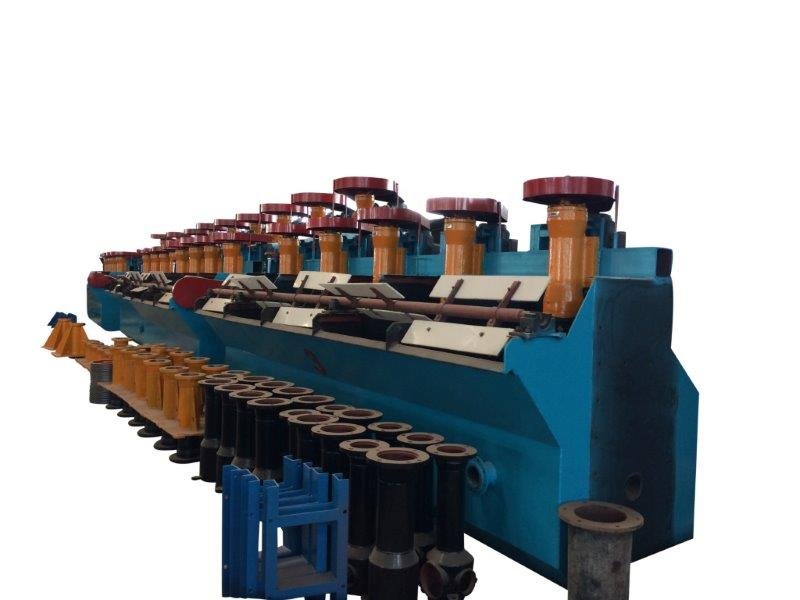Recovery of Molybdenum and Rhenium from Mo Concentrate
As part of the goal to maximize minerals and metals recovery from primary domestic resources, design factors associated with minimizing current leakage in bipolar cell configurations were studied by the Bureau of Mines as a means of improving the efficiency of bipolar electrooxidation cells. Initial studies that were conducted in a small bipolar cell operating […]
Effect of Ion Concentrations on Uranium Absorption
The effect of various ion concentrations on uranium absorption from a sodium carbonate solution by a strong-base, anion resin was investigated by the Bureau of Mines in support of its objective to help assure an adequate uranium supply for future needs. The studies were conducted to improve the recovery of uranium from in situ leach […]
Dodecyl Mercaptan Collector for Sulfide Ores
An analysis of a commercial flotation operation cannot be undertaken without considering the effectiveness and characteristics of the mineral collector. While many operations show satisfactory metallurgical performance, others are characterized by low recoveries of certain metals. Factors such as inadequate liberation, surface oxidation of sulfide minerals, or the adverse or depressing action of some modifying […]
Determination Ionic Activities of Metal Salts in Water
A thorough knowledge of thermodynamic properties of strong electrolytes is useful in leaching processes, purifying dissolved salts and precipitating out selected constituents in aqueous solutions. The data on ionic activities are essential in understanding thermodynamics and kinetics of hydrometallurgical processes. In particular, large changes in the activity coefficients, affected by addition of selected electrolytes, may […]
Copper Ore Crushing, Grinding & Flotation

Crushing and Grinding You will note that the Oracle Ridge project has utilized a two-stage crushing circuit with a double acting jaw crusher and cone crusher. In order to utilize this system, the jaw crusher is oversized to produce all -5 material for the cone mill with a screen in closed circuit. Normally a three-stage […]
Flotation Cells Design & Operating Characteristics

Qualitative Aspects In its essentials, a flotation cell must provide for two main functions. First, it must supply air adequate in quantity and quality for satisfactory process kinetics. Air quantity can be defined on the basis of the narrow range provided in major U. S. commercial cells, for escape velocity, which averages near 1.2 m/min […]
Cristobalite in Fire Clay Calcines
One goal of the Bureau of Mines is to conserve the Nation’s mineral resources by developing improved performance materials. Consistent with this goal, the Bureau conducted studies on the formation of undesirable cristobalite in seven different fire clays used as refractories. The studies employed scanning electron micrography, chemical and X-ray analyses, and pyrometric cone equivalent […]
Countercurrent Ion Exchange
Resin-In-Pulp The Federal American Contactor is currently being used by Federal American Partners, Union Carbide, and Western Nuclear. The system has a single stage per tank as in the Porter System. It is not a fluidized bed system but a system in which the resin is maintained in a slurry suspension by mechanical agitation. The […]
Chalcopyrite Leaching by Thermophilic Bacteria

Research in recent years has been directed toward seeking methods of metal extraction which are less labor and energy intensive, less costly in capital investment and are less insulting to the environment. Chemical metallurgy offers much toward meeting these criteria. Hydrometallurgy offers innovations in copper dump leaching, new developments in in-situ leaching of copper and […]
Remove SO2 from Lead Smelter by Citrate Process
The Federal Bureau of Mines has developed a flue gas desulfurization (FGD) process that uses a carboxylate solution, such as citric acid, to absorb sulfur dioxide (SO2) from industrial waste gases. The absorbed SO3 is subsequently reacted with hydrogen sulfide (H2S) to precipitate sulfur and regenerate the solution for recycle. This process is known as […]
